 |
PO Box 9021,
Wilmington, DE 19809, USA
E-mail: font@focusonnature.com
Phone: Toll-free in USA 1-888-721-3555
or 302/529-1876 |
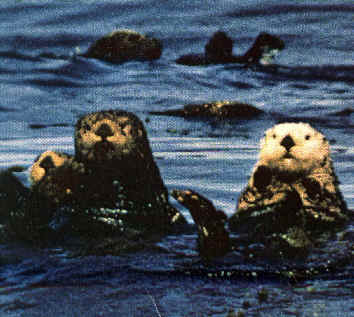 MAMMALS
MAMMALS
land and marine
during Focus On
Nature Tours
in
WASHINGTON STATE
and central
CALIFORNIA
those during our West Coast USA Tours
mostly in the month of September
with an (*)
1991 thru 2014
A list of Washington State
and California mammals compiled by Armas Hill
Photo at upper right: SEA
OTTERS
Codes:
W: in
Washington State
C:
in California
Tours 1991-2001 were also in British Columbia, Canada.
Sightings there are noted with a: B
Numbers following the two-letter codes indicate the number of tours during with the mammal has been found
(out of 13 tours in Washington State and
12 in California)
Species with a PR occur in the area of Point Reyes, California
Noted with their status:
c: common fc: fairly common u: uncommon r: rare x:
extremely rare
SPECIES CLASSIFIED AS THREATENED GLOBALLY:
(t1): critically endangered
(t2): endangered
(t3): vulnerable
(nt): classified as near-threatened globally
(ph): species with a photo in the FONT website
Links:
Upcoming FONT West Coast USA Birding & Nature Tours in
Washington State & California
List
of Birds found during FONT September West Coast USA Tours
Marine Life (inc. Fish, Jellyfish, Mollusks (Shells), &
Arthropods: Crustaceans & Echinoderms)
Directory of Photos in this Website
Land Mammals:
- Montane Shrew (*) ______ W
1
Sorex monticolus
Sorex monticolus
was called the Dusky Shrew.
- Trowbridge's Shrew ______ C
PR:c
Sorex trowbridgii
- Vagrant Shrew ______
C PR:c
Sorex vagrans
- Pacific Shrew ______ C
PR:r
Sorex pacificus
- Shrew Mole ______ C
PR:fc
Neurotrichus gibbsii
- Broad-banded Mole ______ C
PR:fc
Scapanus latimanus
- Virginia Opossum (ph) (*) ______
C
2
PR:c
Didelphis virginiana
- Pallid Bat ______ C
PR:c
Antrozous pallidus
- Silver-haired Bat (ph) ______
C PR:u
Lasionycteris noctivagans
- Western Red Bat ______ C
PR:u
Lasiurus blossevillii
- Hoary Bat ______
C PR:c
Lasiurus cinereus
- Little Brown Myotis ______
C PR:u
Myotis lucifugus
- California Myotis (*) ______
C
2
PR:fc
Myotis californicus
- Fringed Myotis ______ C
PR:c
Myotis thysanodes
- Yuma Myotis ______
C PR:c
Myotis yumanensis
- Big Brown Bat (*) ______ W
C 3
PR:fc
Eptesicus fuscus
- Long-eared Bat ______ C
PR:r
Plecotus townsendii
- Mexican Free-tailed Bat (ph)
______ C PR:fc
Tadarida brasiliensis
- Sewellel ______ C
W PR:r
Aplodontia rufa
(the single member of its genus)
The Sewellel has also been called the Mountain Beaver.
- Northern Raccoon (ph) (*) ______
W
2
PR:c
Procyon lotor
- Ringtail ______ C
PR:r
Bassariscus astutus
- Northern River Otter (*) ______
W
C 2
PR:r
Lontra canadensis
- Short-tailed Weasel ______ C
PR:r
Mustela erminea
- Long-tailed Weasel ______ C
PR:fc
Mustela frenata
- American Mink (ph) ______
C PR:r
Mustela vison
- American Badger (ph)
______ C PR:u
Taxidea taxus
- Spotted Skunk ______ C
PR:u
Spilogale putorius
- Striped Skunk ______
C
PR:c
Mephitis mephitis
- Coyote (ph) (*) ______ W C
8
PR:r
Canis latrans
- Gray Fox (*) ______ W C
2
PR:fc
Urocyon cinereoargenteus
- Red Fox (ph) (*) _____ W
2
PR:r
Vulpes vulpes fulva
(the North
American animal is considered now to be conspecific with the Old World Red Fox,
Vulpes
v. vulpes)
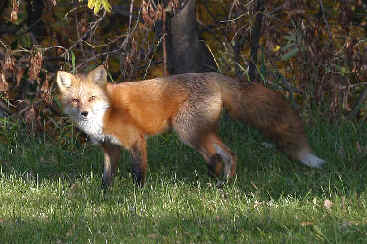
A Red Fox. This mammal is the most widespread and abundant carnivore in the
world.
(photo by Doris Potter)
- Bobcat (ph) (*) ______ C
2
PR:fc
Lynx rufus
- Puma (ph) ______ C
PR:r
Felis concolor
- Hoary Marmot (*) ______
W 1
Marmota caligata
- California Ground Squirrel (ph) (*) ______
C 11 PR:r
Spermophilus beecheyi
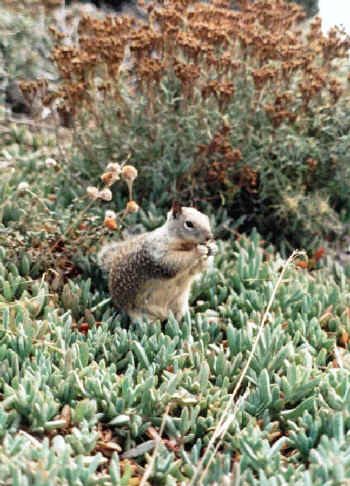
A California Ground Squirrel at Monterey, California
(photo by Armas Hill)
- Washington Ground Squirrel (*) ______
W
2
Spermophilus washingtoni
- Belding's Ground Squirrel (*) ______
W
1
(seen in eastern Wash State,
slightly north of boundary in range maps)
Spermophilus beldingi
- Cascade Golden-mantled Ground Squirrel
(*) ______ W 7
Spermophilus saturatus
The Cascade Golden-mantled Ground Squirrel is a split from
the Golden-mantled Ground Squirrel, Spermophilus
saturatus.
- Townsend's Ground Squirrel (*) ______
W 1
Spermophilus townsendii
- Townsend's Chipmunk (*) ______
W 10
Tamias townsendii
- Yellow-pine Chipmunk (*) ______
W
10
Tamias amoenus
- Merriam's Chipmunk (*) ______ C
6
Tamias merriami
- Least Chipmunk (*) ______ W
2
Tamias minimus
- Panamint Chipmunk (*) ______ C 1
Tamias panamintinus
- Sonoma Chipmunk ______ C
PR:u
Tamias sonormae
- Eastern Gray Squirrel (i/wNA) (ph) (*) ______
W
B 3
Sciurus carolinensis
- Western Gray Squirrel (*) ______
W
C 6
PR:c
Sciurus griseus
- Red (or Spruce)
Squirrel (*) ______ W 4
Tamiasciurus hudsonicus
- Douglas Squirrel (*) ______
W
9
Tamiasciurus douglasii
Tamiasciurus douglasii
is called the "Chickaree"
in the Rocky Mountains.
- North American Porcupine (ph) (*) ______
C W 1 PR:r
Erethizon dorsatum (the single member of its genus)
- Muskrat (ph) (*) ______ C
W 1
PR:u
Ondatra zibethicus
(the single member of its genus)
- Nutria (i) (ph) (*) ______ W 1
Myocastor coypus
(the single member of its genus)
Myocastor coypus
is native to South America, where it is called the Coypu.
- Botta Pocket Gopher ______ C
PR:c
Thormomys bottae
- Western Harvest Mouse ______ C
PR:u
Reitbrodontomys megalotis
- North American Deermouse (*) ______
C W 2
PR:c
Peromyscus maniculatus
- Northwestern Deermouse (*) ______
W 1
Peromyscus keeni
- Pacific Jumping Mouse ______ C
PR:u
Zapus trinotatus
- Dusky-footed Woodrat ______ C
PR:c
Neotoma fuscipes
- California Vole ______ C
PR:c
Microtus californicus
- Norway Rat (i) ______ C
PR:c
Rattus norvegicus
- Western House Mouse (i) ______
C PR:c
Mus domesticus
Mus domesticus
was conspecific with the Eastern House Mouse,
Mus musculus.
- European Rabbit (i) (*) ______ W
6
Oryctolagus cuniculus
(the single member of its genus)
- Mountain Cottontail (*) ______
W
7
Sylvilagus nuttallii
Another name for
Sylvilagus nuttallii is Nuttall's Cottontail.
- Desert Cottontail (ph) (*) ______
C 2
Sylvilagus audubonii
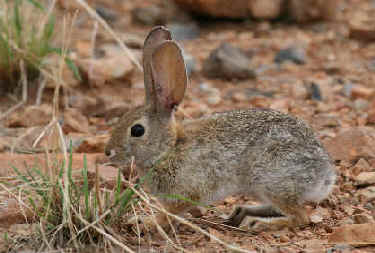
Desert Cottontail, photographed during a FONT tour
- Eastern Cottontail (ph) (*) ______
W 1
Sylvilagus floridanus
There is a western population of the Eastern Cottontail in
Washington State.
- Brush Rabbit (*) ______
C
3
Sylvilagus bachmani
- Black-tailed Jackrabbit (ph)
(*) ______ C 1
PR:c
Lepus californicus
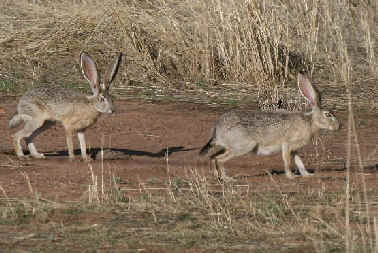
Black-tailed Jackrabbits, photographed during a FONT tour
- "Desert" Bighorn Sheep (ph)
(*) ______ W 1
Ovis canadensis (along with others, in the same genus as Domestic
Sheep)
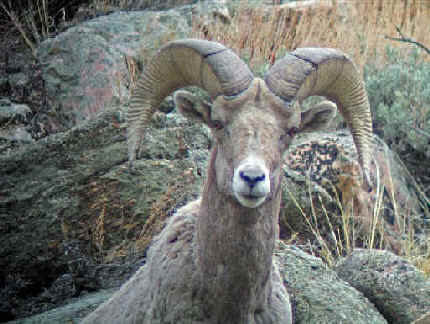
Bighorn Sheep, photographed during a FONT tour
- Elk (or Wapiti) (ph)
(*) ______ W 1
Cervus elaphus canadensis
(another, slightly smaller, subspecies in Europe
is called there the Red Deer)
"Tule Elk" (*) ______ C
1 PR:fc
Cervus elaphus nannodes (a subspecies of
Elk, native to
California)
- Mule Deer (ph) (*) ______ C
W 12
PR:c
Odocoileus hemionus
Odocoileus hemionus
is called Blacktail Deer west of the
Cascades.
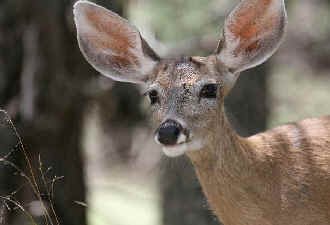
A Mule Deer, with its big ears, photographed during a FONT tour.
- "Columbian"
White-tailed Deer (ph) (*) ______ W 3
Odocoileus virginianus
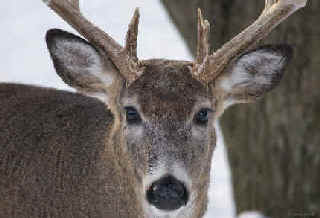
The White-tailed Deer is found throughout nearly all of the Lower 48 states
of the US,
but it does not occur in much of California. It is rather common in
Washington State.
(photo by James Scheib)
(photo by James Scheib)
- (Common) Fallow Deer (i) (ph) (*) ______
C 1 PR:u (feral population in
California)
Dama dama
Dama dama
is native to the Mediterranean region of the Old World.
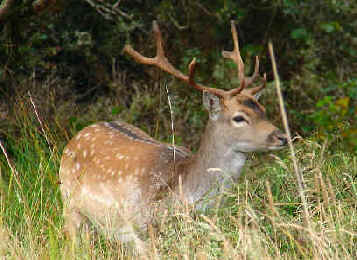
Fallow Deer
(photo by James Scheib)
- Axis Deer (i) ______ C
PR:u
Axis axis
- Wild Pig (i) ______ C
PR:u
Sus scrofa
Marine Mammals:
- Sea Otter (ph) (*) ______ C
12 PR:r
Enhydra lutris
(the single member of its genus)
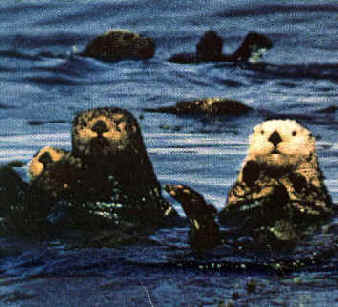
Sea Otters
- California Sea Lion (ph) (*) ______
C
12
PR:c
Zalophus californiannus (the single member of its genus)
The Galapagos Sea Lion, on those islands, is a race of Zalophus
californiannus.
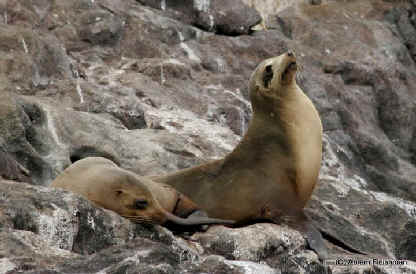
California Sea Lions
(photo by Abram Fleishman)
- Steller's (or Northern) Sea Lion
(*) ______ W
2 PR:u
Eumetopias jubatus
(the single member of its genus)
- Northern Fur Seal (ph) (*) ______
W
C 5
PR:r
Callorbinnus ursinus
(the single member of its genus)
- Harbor Seal (ph) (*) ______
W
C 13
PR:c
Phoca vitulina
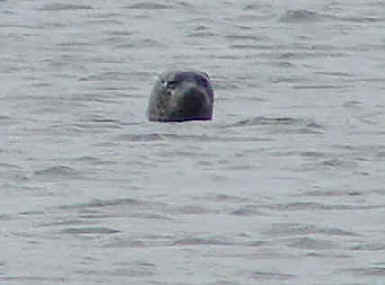
Harbor Seal
(photo by James Scheib)
- Northern Elephant Seal (*) ______
C
2
PR:u
Mirounga angustirostris
- Short-beaked Common Dolphin (ph)
(*) ______ C 7 PR:r
Delphinus delphis
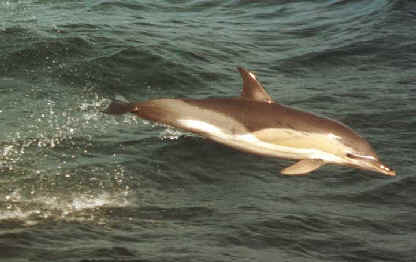
Short-beaked Common Dolphin photographed during a FONT tour
(Photo by Andy Smith)
- Northern Right Whale Dolphin
(*) ______ C
4
PR:r
Lissodelphis borealis
- Pacific White-sided Dolphin (*)
______ C
9
PR:fc
Lagenorhynchus obliquidens
- Risso's Dolphin (ph) (*) ______
C
5
PR:r
Grampus griseus
(the single member of its
genus)
Grampus griseus is also
called Gray Grampus.
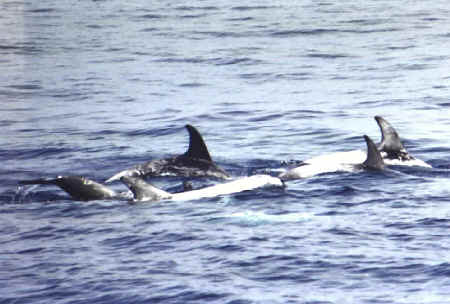
Risso's Dolphins photographed during a FONT tour
- Killer Whale (ph) (*) ______ W
C 3
PR:u
(also called Orca)
Orcinus orca
(the single member of its genus)
Orcas were seen nicely in the Puget
Sound, Washington during the 2004 FONT West Coast Tour.
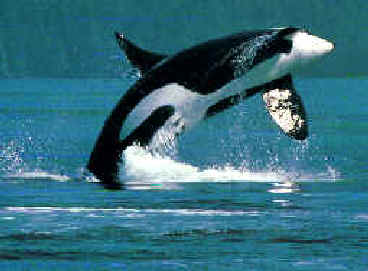
Killer Whale (or Orca)
- Dall's Porpoise (*) ______ W
7
PR:fc
Phocoenoides dalli
(the single member of its genus)
- Harbor Porpoise (t3) ______ PR:r
Phocaena phocaena
- Short-finned Pilot Whale (ph)
(*) ______
C 1
Globicephala macrorhynchus
- Long-finned Pilot Whale (ph)
(*) ______
PR:r
Globicephala scammonii
- Baird's Beaked Whale (ph) (*) ______
C
3
Berardius bairdii
8 Baird's Beaked Whales were nicely seen
during the 2005 FONT tour offshore from Monterey, California. 4 of them were
seen floating, rather like logs, on the surface of the water close to the
boat.
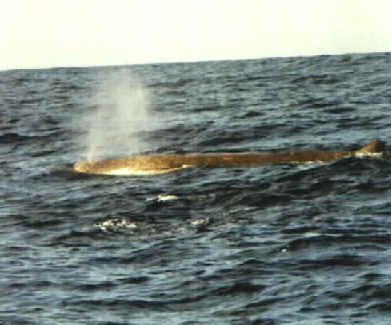
A Baird's Beaked Whale photographed during a FONT West Coast Tour
offshore from Monterery, California
(Photo by Marie Gardner)
- Stejneger's Beaked Whale ______
PR:r
Mesoplodon stejnegeri
- Hubb's Beaked Whale ______ PR:r
Mesoplodon carlbubbsi
- Cuvier's Beaked Whale (ph)
______ PR:r
Ziphius cavirostris
- Great Sperm Whale (t3) (ph)
______ PR:r
Physeter catodon
- Pygmy Sperm Whale (ph)
______ PR:r
Kogia breviceps
- Gray Whale (*) ______ C
1
PR:c
Eschrichtius robustus
(the single member of its genus)
- Northern Minke Whale (ph) (*) ______
W
1
PR:r
Balacnoptera acutorostrata
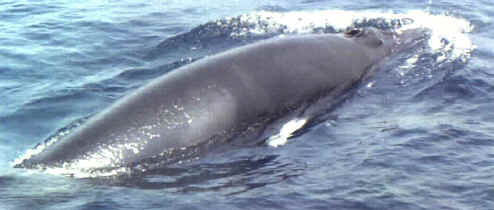
A Northern Minke Whale photographed during a FONT tour
- Humpback Whale (t3) (ph) (*) ______
C
8 PR:fc
Megaptera novaeanliae
(the single member of its genus)
8 Humpback Whales were observed during the 2005 FONT tour offshore from
Monterey, California. Some were seen breaching out of the water, including a
mother with her calf.
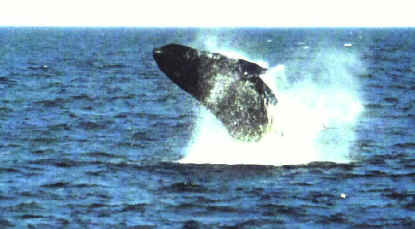
A breaching Humpback Whale
- Sei Whale (t2) ______ PR:r
Balaenoptera borealis
- Finback Whale (t2) (ph)
______ PR:r
Balaenoptera physalus
- Blue Whale (t2) (ph) (*) ______
C
3
PR:u
Balaenoptera m. musculus
(subspecies in the North Pacific and North Atlantic Oceans; 2 other
subspecies in the Southern Hemisphere)
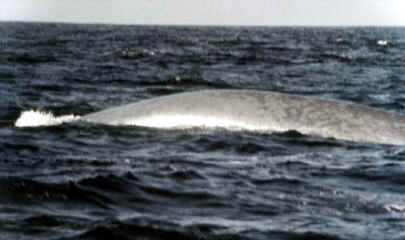
A Blue Whale, the largest animal in the world,
photographed offshore from Monterey, California
(Photo by Armas Hill)
During the pelagic trip from Monterey, California on September 17, 2005,
during which the Baird's Beaked Whales and Humpback Whales referred to above
were seen, there were also many seabirds, including an Hawaiian Petrel (a
mega-rarity off the California coast).
Reference for the above mammal list is the new book:
"Mammals of North America" by Roland W. Kays & Don E. Wilson,
published by Princeton University Press, 2002.

Some
Other Wildlife during the FONT West Coast USA Tours:
Leatherback Sea Turtle (ph) _____ C 1
Blue Shark _____ C 3
Thresher Shark _____ C 1
Ocean Sunfish (ph) _____ C 3
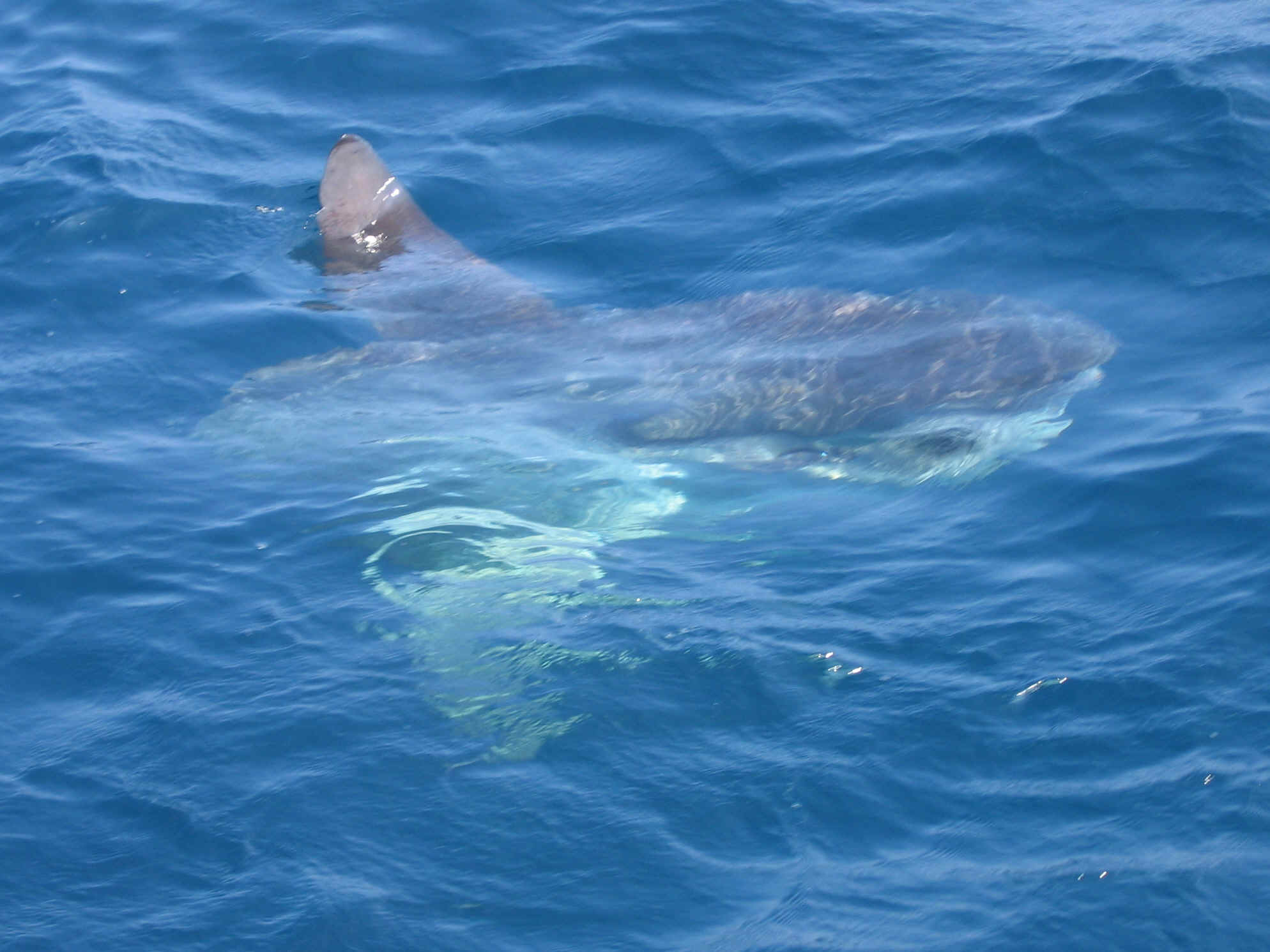
Ocean Sunfish
(photographed during a FONT tour)




















![]()
